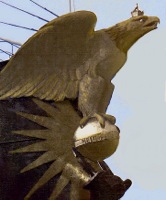File:Imp eagle 1913.jpg
Imp_eagle_1913.jpg (166 × 200 pixels, file size: 12 KB, MIME type: image/jpeg)
http://www.cityofart.net/bship/figurehead.htm
Figureheads were not limited to ships of war, however; occasionally the anachronism crept into commerce as well, usually in a chauvinistic quest for national one-upmanship. Such was the case with the 52,000-ton ocean liner Imperator, flagship of the Hamburg-Amerika Line fleet, entering service in 1913 with much fanfare as the largest ship afloat. When the next year the rival Cunard Line debuted the even longer Aquitania, Imperator went into drydock for a quick refit and emerged with several tons of gold-leafed bronze sculpture attached to the very bow of the ship -- a gung-ho Teutonic eagle with wings spread and talons clutching the globe, inscribed with the HAPAG motto Mein Felt ist die Welt, and wearing a ridiculously tiny crown on its head. This sculpture added enough feet to Imperator's over-all length that her owners could once again claim to have the world's longest liner.
The imposing figurehead did not fare so well in combat with the Atlantic wave, however. Monster waves first washed away the statue's wings, then bashed in its body on a subsequent voyage. When the ship was taken over by the Americans in 1917 for conversion to a troopship -- one of a large fleet of German liners interned in American ports at war's outbreak and turned against the Fatherland when the U.S. declared war -- the eagle was painted over with dazzle-pattern paint. She sailed as a troopship, along with an entire fleet of German liners interned in American ports, including her sister-ship Vaterland. Thus ships built in the Kaiser's yards hastened the deafeat of the Fatherland. Albert Ballin, the guiding genius of the Hamburg-Amerika Line, committed suicide as Germany crashed in ruins about him, the Kaiser fleeing to Holland in disgrace. After the War, all three of Ballin's sensational superliners were awarded to the Allies as reparations -- the Imperator, Vaterland, and the incomplete Bismarck -- to sail through the Twenties as the Cunard flagship Berengaria, the United States Lines' flagship Leviathan, and the White Star flagship Majestic, respectively. While the ex-Imperator was being recreated for peacetime service, the eagle figurehead fell victim to the welder's torch. In fact, a great portion of the German liners' extravagant original fittings reappeared in Hoboken-area pubs and hotels, where they remain to this day. This is not surprising: Hoboken was the German liners' New York terminus, where the ships were interned and captured, and where they were converted to troopships in 1917.
But to return to our main object of study, the battleship. Shortly after the turn of the 20th century -- around the time of the Dreadnought's appearance in 1906 --, these decorative pretensions vanished; the seriousness of the battleship's warlike purpose was more plainly stated as the drift toward war accelerated. The black-and-yellow paint schemes were changed to battleship grey over all and decorative flourishes on the hulls were eliminated too.
File history
Click on a date/time to view the file as it appeared at that time.
| Date/Time | Thumbnail | Dimensions | User | Comment | |
|---|---|---|---|---|---|
| current | 19:51, 27 January 2013 |  | 166 × 200 (12 KB) | Rdavis (talk | contribs) | http://www.cityofart.net/bship/figurehead.htm Figureheads were not limited to ships of war, however; occasionally the anachronism crept into commerce as well, usually in a chauvinistic quest for national one-upmanship. Such was the case with the 52,000-t |
You cannot overwrite this file.
File usage
The following page uses this file: